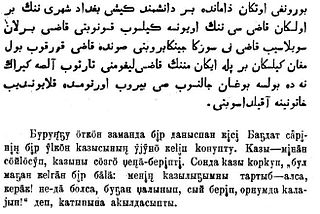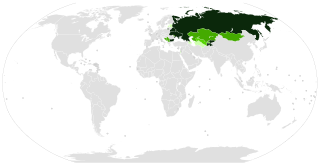
Kazakh or Qazaq is a Turkic language of the Kipchak branch spoken in Central Asia by Kazakhs. It is closely related to Nogai, Kyrgyz and Karakalpak. It is the official language of Kazakhstan and a significant minority language in the Ili Kazakh Autonomous Prefecture in Xinjiang, north-western China, and in the Bayan-Ölgii Province of western Mongolia. The language is also spoken by many ethnic Kazakhs throughout the former Soviet Union, Germany, and Turkey.

Kyrgyz is a Turkic language of the Kipchak branch spoken in Central Asia. Kyrgyz is the official language of Kyrgyzstan and a significant minority language in the Kizilsu Kyrgyz Autonomous Prefecture in Xinjiang, China and in the Gorno-Badakhshan Autonomous Region of Tajikistan. There is a very high level of mutual intelligibility between Kyrgyz, Kazakh, and Altay. A dialect of Kyrgyz known as Pamiri Kyrgyz is spoken in north-eastern Afghanistan and northern Pakistan. Kyrgyz is also spoken by many ethnic Kyrgyz through the former Soviet Union, Afghanistan, Turkey, parts of northern Pakistan, and Russia.

The Russian alphabet is the script used to write the Russian language. It comes from the Cyrillic script, which was devised in the 9th century for the first Slavic literary language, Old Slavonic. Initially an old variant of the Bulgarian alphabet, it became used in the Kievan Rusʹ since the 10th century to write what would become the modern Russian language.

Bashkir or Bashkort is a Turkic language belonging to the Kipchak branch. It is co-official with Russian in Bashkortostan. It is spoken by 1.09 million native speakers in Russia, as well as in Ukraine, Belarus, Kazakhstan, Uzbekistan, Estonia and other neighboring post-Soviet states, and among the Bashkir diaspora. It has three dialect groups: Southern, Eastern and Northwestern.

The Cyrillic I is a letter used in almost all Cyrillic alphabets with the exception of Belarusian.
Three scripts are currently used for the Tatar language: Arabic, Cyrillic and Latin.

The soft sign is a letter in the Cyrillic script that is used in various Slavic languages. In Old Church Slavonic, it represented a short or reduced front vowel. However, over time, the specific vowel sound it denoted was largely eliminated and merged with other vowel sounds.

Yeru or Eru, usually called Y in modern Russian or Yery or Ery historically and in modern Church Slavonic, is a letter in the Cyrillic script. It represents the close central unrounded vowel after non-palatalised (hard) consonants in the Belarusian and Russian alphabets, and after any consonant in most of Rusyn standards, where it represents the unrounded close-mid back unrounded vowel sound.
The Common Turkic alphabet is a project of a single Latin alphabet for all Turkic languages based on a slightly modified Turkish alphabet, with 34 letters recognised by the Organization of Turkic States. Its letters are as follows:

The Belarusian alphabet is based on the Cyrillic script and is derived from the alphabet of Old Church Slavonic. It has existed in its modern form since 1918 and has 32 letters. See also Belarusian Latin alphabet and Belarusian Arabic alphabet.

Three alphabets are used to write Kazakh: the Cyrillic, Latin and Arabic scripts. The Cyrillic script is used in Kazakhstan and Mongolia. An October 2017 Presidential Decree in Kazakhstan ordered that the transition from Cyrillic to a Latin script be completed by 2031. The Arabic script is used in Saudi Arabia, Iran, Afghanistan, and parts of China.

The Tajik language has been written in three alphabets over the course of its history: an adaptation of the Perso-Arabic script, an adaptation of the Latin script and an adaptation of the Cyrillic script. Any script used specifically for Tajik may be referred to as the Tajik alphabet, which is written as алифбои тоҷикӣ in Cyrillic characters, الفبای تاجیکی with Perso-Arabic script and alifboji toçikī in Latin script.

The Uzbek language has been written in various scripts: Latin, Cyrillic and Arabic. The language traditionally used Arabic script, but the official Uzbek government under the Soviet Union started to use Cyrillic in 1940, which is when widespread literacy campaigns were initiated by the Soviet government across the Union. In Uzbekistan, the Latin script was officially reintroduced, along with Cyrillic, in 1992, and a full transition to Latin script is awaiting implementation. In neighboring Kyrgyzstan and Tajikistan, people use Cyrillic. In the Xinjiang region of China, some Uzbek speakers write using Cyrillic, others with an alphabet based on the Uyghur Arabic alphabet. Uzbeks of Afghanistan also write the language using Arabic script, and the Arabic Uzbek alphabet is taught at some schools in the country.

Numerous Cyrillic alphabets are based on the Cyrillic script. The early Cyrillic alphabet was developed in the 9th century AD and replaced the earlier Glagolitic script developed by the theologians Cyril and Methodius. It is the basis of alphabets used in various languages, past and present, Slavic origin, and non-Slavic languages influenced by Russian. As of 2011, around 252 million people in Eurasia use it as the official alphabet for their national languages. About half of them are in Russia. Cyrillic is one of the most-used writing systems in the world. The creator is Saint Clement of Ohrid from the Preslav literary school in the First Bulgarian Empire.
The Cyrillic script family contains many specially treated two-letter combinations, or digraphs, but few of these are used in Slavic languages. In a few alphabets, trigraphs and even the occasional tetragraph or pentagraph are used.
JCUKEN is the main Cyrillic keyboard layout for the Russian language in computers and typewriters. Earlier in Russia JIUKEN (ЙІУКЕН) layout was the main layout, but it was replaced by JCUKEN when the Russian alphabet reform of 1917 removed the letters Ѣ, І, Ѵ, and Ѳ. The letter Ъ had decreased in usage significantly after the reform.

Latin yeru or I with bowl is an additional letter of the Latin alphabet based on the Cyrillic soft sign. It was introduced in 1928 into the reformed Yañalif, and later into other alphabets for Soviet minority languages. The letter was designed specifically to represent the non-front close vowel sounds IPA:[ɨ] and IPA:[ɯ]. Thus, this letter corresponds to the letter ⟨I ı⟩ in modern Turkic alphabets, and the letter yery in Cyrillic.
The Komi language, a Uralic language spoken in the north-eastern part of European Russia, has been written in several different alphabets. Currently, Komi writing uses letters from the Cyrillic script. There have been five distinct stages in the history of Komi writing:
Since its inception in the 18th century and up to the present, it is based on the Cyrillic alphabet to write the Udmurt language. Attempts were also made to use the Latin alphabet to write the Udmurt language. In its modern form, the Udmurt alphabet was approved in 1937.
Khakass alphabets are the alphabets used to write the Khakas language.













